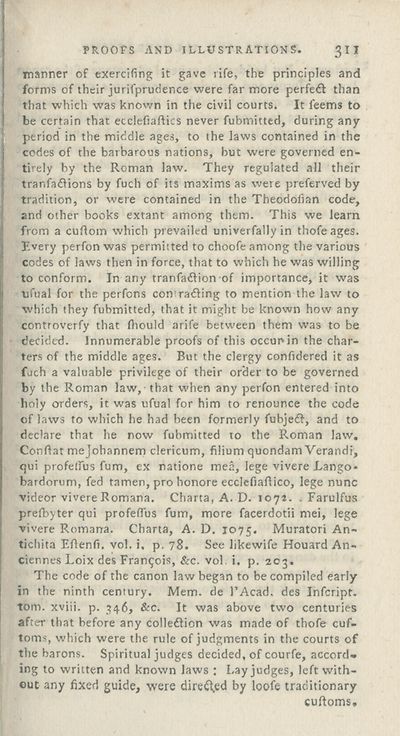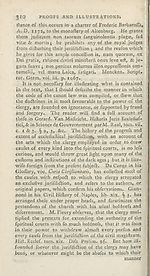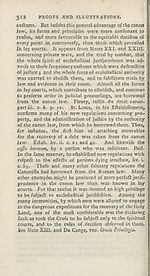Download files
Complete book:
Individual page:
Thumbnail gallery: Grid view | List view

PROOFS AND ILLUSTRATIONS. 3II
manner of exercifing it gave rife, the principles and
forms of their jurifprudence were far more perfeft than
that which was known in the civil courts. It feems to
be certain that ecclefiaftics never fubmitted, during any
period in the middle ages, to the laws contained in the
codes of the barbarous nations, but were governed en¬
tirely by the Roman law. They regulated all their
tranfaflions by fuch of its maxims as were preferved by
tradition, or were contained in the Theodofian code,
and other books extant among them. This we learn
from a cuflom which prevailed univerfally in thofe ages.
Every perfon was permitted to choofe among the various
codes of laws then in force, that to which he was willing
to conform. In any tranfadfion of importance, it was
uftial for the perfons con'rafting to mention the law to
which they fubmitted, that it might be known how any
controverfy that fhould arife between them was to be
decided. Innumerable proofs of this occunin the char¬
ters of the middle ages. But the clergy confidered it as
fuch a valuable privilege of their order to be governed
by the Roman law, that when any perfon entered into
holy orders, it was ufual for him to renounce the code
of laws to which he had been formerly fubjeft, and to
declare that he now fubmitted to the Roman law.
Conflat mejohannem clericum, filium quondam Verandi,
qui profelfus fum, ex natione mea, lege vivere Lango*
bardorum, fed tamer, pro honore ecclefiartico, lege nunc
videor vivere Romana. Charta, A. D. 1071. . Farulfus
prefbyter qui profeflus fum, more facerdotii mei, lege
vivere Romana. Charta, A. D. 1075. Muratori An-
tichita Eflenfi. vol. i. p. 78. See likewife Houard An-
ciennes Loix des Franqois, &c. vol i. p. 203.
The code of the canon law began to be compiled early
in the ninth century. Mem. de 1’Acad. des Infcript.
tom. xviii. p. 346, &c. It was above two centuries
after that before any colleftion was made of thofe cuf-
toms, which were the rule of judgments in the courts of
the barons. Spiritual judges decided, of courfe, accord¬
ing to written and known laws ; Lay judges, left with¬
out any fixed guide, were diredt,ed by loofe traditionary
cuftoms.
manner of exercifing it gave rife, the principles and
forms of their jurifprudence were far more perfeft than
that which was known in the civil courts. It feems to
be certain that ecclefiaftics never fubmitted, during any
period in the middle ages, to the laws contained in the
codes of the barbarous nations, but were governed en¬
tirely by the Roman law. They regulated all their
tranfaflions by fuch of its maxims as were preferved by
tradition, or were contained in the Theodofian code,
and other books extant among them. This we learn
from a cuflom which prevailed univerfally in thofe ages.
Every perfon was permitted to choofe among the various
codes of laws then in force, that to which he was willing
to conform. In any tranfadfion of importance, it was
uftial for the perfons con'rafting to mention the law to
which they fubmitted, that it might be known how any
controverfy that fhould arife between them was to be
decided. Innumerable proofs of this occunin the char¬
ters of the middle ages. But the clergy confidered it as
fuch a valuable privilege of their order to be governed
by the Roman law, that when any perfon entered into
holy orders, it was ufual for him to renounce the code
of laws to which he had been formerly fubjeft, and to
declare that he now fubmitted to the Roman law.
Conflat mejohannem clericum, filium quondam Verandi,
qui profelfus fum, ex natione mea, lege vivere Lango*
bardorum, fed tamer, pro honore ecclefiartico, lege nunc
videor vivere Romana. Charta, A. D. 1071. . Farulfus
prefbyter qui profeflus fum, more facerdotii mei, lege
vivere Romana. Charta, A. D. 1075. Muratori An-
tichita Eflenfi. vol. i. p. 78. See likewife Houard An-
ciennes Loix des Franqois, &c. vol i. p. 203.
The code of the canon law began to be compiled early
in the ninth century. Mem. de 1’Acad. des Infcript.
tom. xviii. p. 346, &c. It was above two centuries
after that before any colleftion was made of thofe cuf-
toms, which were the rule of judgments in the courts of
the barons. Spiritual judges decided, of courfe, accord¬
ing to written and known laws ; Lay judges, left with¬
out any fixed guide, were diredt,ed by loofe traditionary
cuftoms.
Set display mode to:
![]() Universal Viewer |
Universal Viewer | ![]() Mirador |
Large image | Transcription
Mirador |
Large image | Transcription
| Antiquarian books of Scotland > Kings & rulers > History of the reign of the Emperor Charles V. > Volume 1 > (329) |
|---|
| Permanent URL | https://digital.nls.uk/109186279 |
|---|
| Description | By William Robertson. London : Cadell and Davies, 1798. |
|---|---|
| Shelfmark | ABS.1.76.13 |
| Additional NLS resources: | |
| Description | Thousands of printed books from the Antiquarian Books of Scotland collection which dates from 1641 to the 1980s. The collection consists of 14,800 books which were published in Scotland or have a Scottish connection, e.g. through the author, printer or owner. Subjects covered include sport, education, diseases, adventure, occupations, Jacobites, politics and religion. Among the 29 languages represented are English, Gaelic, Italian, French, Russian and Swedish. |
|---|

